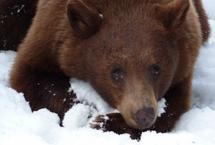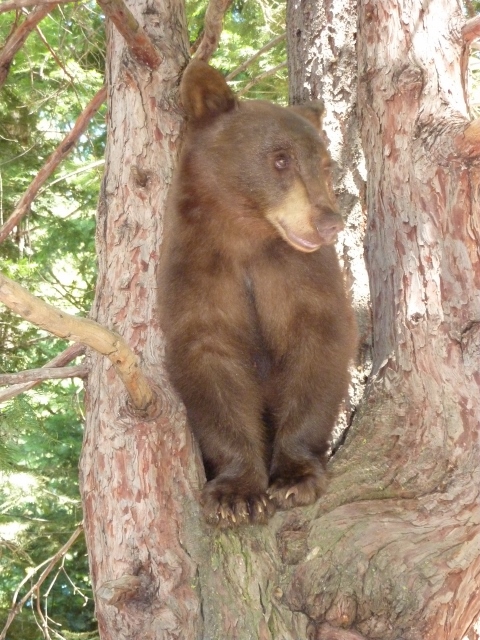saveourplanetearth.com
Call us: (775) 831-1331
Black Bear, Part 1
Anyone who lives in wildlife country, such as we do here at Lake Tahoe, owes it to himself to attend a presentation given by Ann Bryant, Executive Director and Founder of the Bear League, an organization dedicated to keeping bears safe and in their natural habit since 1998.
Even the most distant among us can’t fail to be moved by the incredible stories Ann has to share of her numerous encounters with bears.
The presentation begins with the story of Natalie, a mother bear with two cubs residing on the west shore of Lake Tahoe during the summer of 1998.
A tourist was renting a cabin in the area and had improperly stored garbage which naturally attracted a bear. This tourist was afraid of the bear and called the California Department of Fish and Game to “deal with the problem” he had created.
A trap was set. Instead of the “offending” bear, it was the mother bear that entered the trap and was subsequently killed, along with one of her cubs that was captured by Wildlife Services.
The residents of the area were outraged and decided that something had to be done about this so the Bear League was formed, their first mission being to take care of the cub that escaped capture and was found by residents, crying in a tree.
Since then, the group has grown to nearly 2,000 members, all volunteer –people who believe it is possible to live in harmony with bears.
Many people are afraid of bears, which is due, in part, to ignorance. It’s important to understand that the black bear is not by nature aggressive. He’s big, so he’s scary when actually, he’s more afraid of you than you are of him.
We learned from Ann “what bears are saying”. Often when one encounters a bear out in the woods, the bear will stand up. Most people will interpret this as the bear being aggressive but this is not the case. The bear is curious and he is standing up to better see this person who is wandering about in his woods.
Another thing a bear might do is lower his head. The uninitiated might take this to mean that the bear is about to attack. Actually, the opposite is true. What this indicates is that the bear is reluctant to engage in combat. His head is lowered and his nose may be dripping which means that the bear is afraid.
I personally have had several bear encounters out on my walks and have never felt threatened. One memorable encounter was with “Charlie the Bear”.
I was on my way back on my usual route when I ran into Charlie as he was heading toward the Ponderosa property. He was a short distance away when we saw each other. We both stopped. He stood. Then he took a step toward me. I realized that he needed to continue on the way he was headed as there was someone else behind him.
So I simply turned around and went a different way home, with the bear trailing behind me. It was a short time after that that he was captured in the Raley’s Center in Incline Village and killed, which really pushed me over the edge as I felt I had forged a connection with him that day in the woods.
That is the point at which I added my voice to the fight against the bear hunt and to the killing of “nuisance bears”. We are wrong to kill them.
Those of us in attendance at the presentation learned about the life cycle of a bear. Female bears are called sows and usually produce a litter at around age four.
The bears mate in the summer months, but implantation does not occur until November, at which time the female goes into hibernation. The birth occurs in mid-January to February inside the den, typically two or three cubs.
The cubs remain with their mother for that summer and through the next hibernation. Sometime after that, the cubs are “kicked out of the house” and they are on their own. The female offspring are allowed to stay in the area but the males are forced to leave and this is the time when the yearlings, as they are called, can get themselves into trouble.
You’ll hear the story of “Rudy”, one such yearling that Ann had several encounters with during the early years of the Bear League. We’ll continue this topic in two weeks with more interesting bear stories, such as “The Rainbow Bridge Rescue” and “The Bear Who Got Drunk”.
Ann has so many fascinating and touching stories, this series may last through three columns but we will finish up with ways interested individuals can join the effort to protect these sentient creatures. Until next time!
Bear cub rescued by the BEAR League.
The bear called Sunny, allegedly killed by a resident on the West Shore.
"Bitsy" the bear, resting in the snow.





